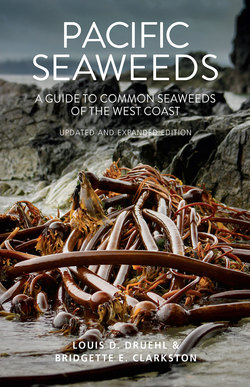Читать книгу Pacific Seaweeds - Louis Druehl - Страница 67
На сайте Литреса книга снята с продажи.
ОглавлениеGreen Seaweeds | 67
Identifying Pacific Seaweeds
Several studies by Japanese and Italian researchers have shown that a seaweed’s morphology may be dependent on certain epiphytic marine bacteria. When grown in aseptic (free from bacteria) cultures, Ulva and other green seaweeds lose their natural leafy morphology and grow instead into a loose collection of cells. If grown with bac-teria, or even just a certain chemical isolated from bac-teria, the seaweeds develop as normal. These fascinating studies give a glimpse into the chemical communica-tion between seaweeds and micro-organisms in their environment that we have yet to fully understand.
Habitat & Distribution
Tubular Ulva are distributed throughout the intertidal zone, from Alaska to Mexico. Ulva intestinalis is the most common species and is cosmopolitan, being found growing on rock on all continents. It is often associated with freshwater seepages above the high tide level and in high tide pools, which through evaporation become salty to the point of producing crystalline salt. Ulva compressa often grows on other seaweeds and is not associated with fresh water. Ulva linza grows on rock or cobble in the mid- to low intertidal region.
A collection of short, individual Ulva sp. cylinders creates a carpet atop a rock.
Ulva intestinalis and cross-section (left) showing tubular nature of the plant.
